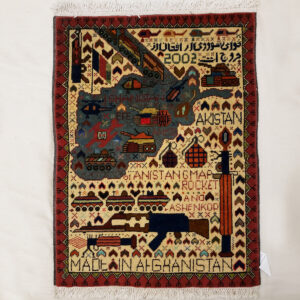
02 Jan Afghan War Rugs
Online Exclusive
The war rug tradition of Afghanistan has its origins in the decade of Soviet occupation that began in 1979 and has continued through the subsequent military, political and social conflicts. Afghan rug-makers began incorporating the apparatus of war into their designs almost immediately after the Soviet Union invaded their country. They continue to do so today in the wake of the United States’ 2001 invasion of Afghanistan which ousted the Taliban government of Mullah Omar but has failed to bring an end to violence in the country. The rugs produced in response to these events are among the world’s richest traditions of war art of the late 20th and early 21st centuries.
The terms Baluch and war rug are generalizations given to the genre by rug dealers, commercial galleries, collectors, critics, and commentators. The distinctive characteristic of these rugs is their capacity to convey their makers’ experiences and interpretations of the circumstances and politics of war and conflict in the region. Many of the themes present on rugs made during the Afghan conflict with the former USSR have been reused and remade, but with specific text and imagery customized for other invading and occupying forces, and those made in reaction to the presence of American military forces remain the most collectible. Ironically, the biggest importers of these rugs have been American soldiers. Some rugs have been known to address the events of 9/11, and more recently – since 2015 – drones have appeared as subject matter. But the era between 2002 and 2011 are generally the most highly sought and the examples herein are known as Exodus rugs.
Exodus rugs are a type of prayer rug (ie. to be used in daily Islamic prayer). They were originally woven in Kharghai (workshops) in Northeast Afghanistan. They are so-called because they picture a map of Afghanistan (in a vernacular adaptation of the Map embroideries of Italian artist Alighiero e Boetti) and show the ejection or retreat of invading forces, frequently with text written in both Pashto and English. The craftsmanship on these Exodus rugs hit peaks in 2002 and 2004 and finally in 2010. Thereafter, the rugs were produced produced tribally or in refugee camps and not in the Afghan villages where the craft was born. Unfortunately, by 2011 the majority of the craftsmen who had pioneered the artform were dead. The example in this collection dated 2011 is an incredible example of a tribal rug, which showcases the decline of technique and the disappearance of Kharghai after ten years of war with the United States. It is also an exceptionally rare for a rug to bear this date, since 2011 was the year of greatest instability in the region. It is also an exceptionally rare example of a Unity rug that pictures both the US and Afghan Flag and a dove of peace, and the particular attention this artist paid to the beautiful emblem in the flag of Afghanistan in noteworthy. From 2012 onward, the majority of these rugs were produced specifically as souvenirs for export in refugee camps near Tora Bora and Sherberghan.
War Rugs are a culturally significant style of folk art that gives context to conflict, and are quite different from propaganda. They also showcase within a single medium the impact of war upon the craft of a culture.
All of these rugs are generally sized 24 x 33 in. Click the images below to purchase online with our safe and secure shopping cart. Call or email the gallery to discuss other payment and delivery options.
Matt Kennedy
Gallery Director
(323)547-3227
gallery30south@gmail.com
-
Afghan War Rug: 2002 (Air Planes)
$750 -
Afghan War Rug: 2002 (Grey)
$800 -
Afghan War Rug: 2002 (Klashenko)
$750 -
Afghan War Rug: 2002 (Rocket)
$750 -
Afghan War Rug: 2004
$800 -
Afghan War Rug: 2005 (Airplanes)
$800 -
Afghan War Rug: 2005 (Airplat)
$750 -
Afghan War Rug: 2006 (Undated)
$750 -
Afghan War Rug: 2010
$750 -
Afghan War Rug: 2011 (Tribal Unity)
$2,400










